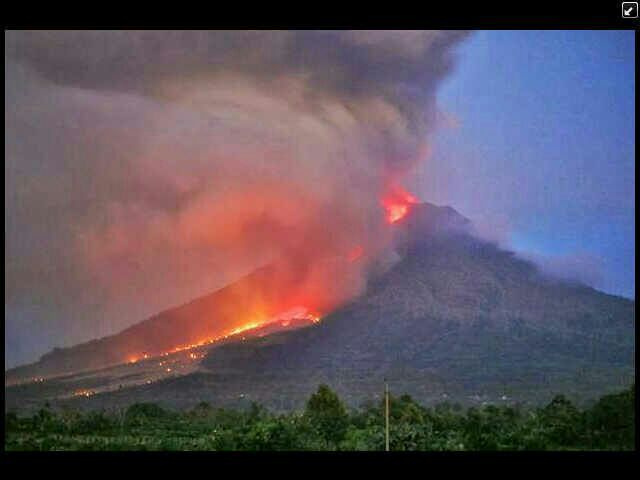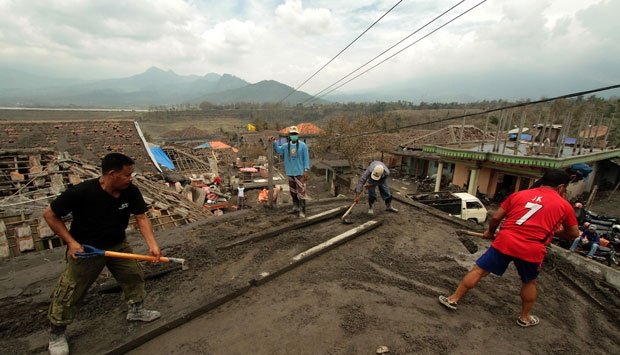Menyingkap Jejak Ketangguhan Bencana Masyarakat Lereng Gunung Kelud
Information
TIMESINDONESIA, SURABAYA –
Mount Kelud is one of the active volcanoes in East Java. Exactly February 13, 2014 or seven years ago, this volcano erupted tremendously. However, 870 thousand people managed to survive the threat of the eruption.
ITS Earth and Disaster Expert, Dr Ir Amien Widowo in the online seminar of the Indonesian Tangguh Society revealed the journey of the eruption of Mount Kelud.
“If we look at the journey of Mount Kelud,it is very long. What could have been recorded well before 2007 was from the beginning a good lake became a child of Mount Kelud in November 2007,” he explained, Sunday (21/2/2021).

Poster of Open Talk by Masyarakat Tangguh Indonesia, Sunday 21 February 2021
The long history of the eruption of Mount Kelud has even buried the surrounding civilizations. Including the time of the Majapahit civilization. Where partially buried about 2 meters or so. The remains of that civilization can be found through excavations or unexpected discoveries.
In 1901 the eruption of Mount Kelud had reached the farthest radius. Before 1920, Kelud erupted again but the eruption was in the form of a flash flood of lava.
“At that time, because there was a very deep crater lake, the eruption was in the form of a mudflow eruption before 1920,” explained Amien.
The height of the eruption of Mount Kelud can even reach 23 kilometers so that the range of the eruption can be very far. Rocks about 6.4 cm in size can spread up to 10 kilometers if the eruption occurs vertically
.

Mount Kelud eruption in 2014 (source: Geologi.co.id)
So, how do the people who lives at the slopes of Kelud adapt to the threat of this permanent disaster?
Secretary General of the East Java Disaster Risk Reduction Forum (FPRB) and Chairman of the Catur Kelud Anchor Community, Sudharmanto, revealed that the resilience of the Kelud slopes is not a coincidence. However, it has gone through a very long process with mitigation and preparedness provisions. The intervention of the training process and social capital in building preparedness actually took a long time.
“This means that mitigation and preparedness have become part of the Kelud slope community,” said Catur.
Eruption preparedness activities also involve community experiences from the past and the roles of a group of people, organizations or government institutions that care about community resilience.
The presence of the Jangkar Kelud Community since 2008 itself, explained Catur, aims to reduce disaster risk. Jangkar Kelud itself means Jangkane Kawula Redi Kelud. Jangkane means hope. Kawula means community and Redi Kelud is the Kelud volcano.

Residents started cleaning their homes from the remaining sand and mud from the eruption of Mount Kelud (source:Tempo.co)
The Jangkar Kelud Community Association as a non-profit organization has a mission to build a strong community in the face of the Kelud volcano disaster through capacity building.
In practice, Jangkar Kelud provides sustainable mitigation to residents. Likewise, when an eruption occurs, the community also immediately spreads the latest information to the public. “We got the exact same information from the Volcano Monitoring Post (PGA),” he added.
Catur added, the information they received was A1. Furthermore, it is distributed to community members holding handy talky (HT) and forwarded to community leaders and village alert teams. Jangkar Kelud has 9 community radios spread across three districts. Namely Kediri Regency, Blitar Regency and Malang Regency as the administrative area of Mount Kelud. So that people get information faster with more effective results.
“We convey the latest information on the development of Kelud to the public. The key is here,” he explained.
The community was only given less than half a month when they had to prepare everything to avoid the threat of an eruption of Kelud when the mountain began to show volcanic activity.

Observation Post of Mount Kelud (source: Solo Pos)
Of these various efforts, it is not surprising that the devastating eruption of Mount Kelud in 2017 did not claim any lives during the eruption. In fact, in just one hour the people had to save themselves.
The change in the status of Mount Kelud happened very quickly, unlike previous eruptions. This eruption made a scene for many parties. On Sunday (2/2/2014) the status changed to Alert. Monday (10/2/2014) the status went up again from Waspada to Alert until finally there was an eruption on Thursday (13/2/2014) night. Mount Kelud changed its status to Awas, meaning tens of thousands of people had to flee with little preparation time.
Even though 2014 was the worst eruption of Mount Kelud. The eruption of Mount Kelud at that time spewed 150 million cubic meters of material. In the history of the eruption of Mount Kelud during the last 100 years, this eruption was the largest eruption. However, there was not a single victim in three districts, namely Kediri, Blitar and Malang. The number of refugees reached 57,438 people spread over 96 points in the affected areas.
Even though the short transition in half a month is fairly fast. The 2014 eruption of Mount Kelud was truly devastating.
Even though the time is short, the reality is that people can evacuate independently. Before the eruption, Jangkar Kelud has conducted training workshops in 36 villages.
“Maybe this is a picture that has never been exposed by the media,” said Catur who has been living in a village which is 8-9 kilometers from the summit of Mount Kelud.

President of Indonesia,Susilo Bambang Yudhoyono had a dialogue with refugees of Mount Kelud Eruption (source: Humasbatu.blogspot.com)
Mount Kelud, with an altitude of 1,731 meters above sea level, erupted on Thursday (13/2/2014) night and spewed the contents of its reservoir in the form of sand, dust and boulder-sized stones. A total of 87,000 people were rescued from the massive eruption.
This, he explained, clearly shows the central role of society in disaster management. The community, including elements of local government and others, have taken the initiative to carry out disaster management, starting from education.
Meanwhile, the people of Kelud may not perceive the eruption as a threat. But realizing that life is friendly to disaster. After the eruption, the people returned from their evacuation to their respective villages.
At present, post-eruption recovery focuses on infrastructure development and agricultural land, especially chili crops. However, within one month the chili plants began to shoot back.
“When people focus on infrastructure, it turns out that especially the chili plants have started to shoot back,” added Catur.

Reforestation activities in Petung Ombo hamlet, a forest area at the downhill of Mount Kelud (source: Jangkarkelud.blogspot.com)
There are new adaptations to environmental conditions. Especially those who live on the banks of the Kali Kunto River. Meanwhile, agricultural land could not be used. The residents ended up doing mining on the banks of the river regardless of whether the mining was illegal or licensed.
“It turns out that the recovery on Mount Kelud is a lot assisted by the natural conditions themselves,” he said (*)
Latest News
-
Pertajam Keilmuan Petrofisikamu dengan Studi Kasus Di Dunia Oil and Gas, dalam PETROPHYSICS TRAINING 2025!
Teknik Geofisika ITS mengajak anda untuk mendalami pengetahuan dan masalah-masalah yang terjadi seputar Petrofisika dalam acara PETROPHYSICS TRAINING 2025.
-
Kuliah Tamu “Bahaya Geologi Penurunan Tanah Daerah Pesisir Pantai Utara Jawa”
Teknik Geofisika ITS menyelenggarakan Kuliah Tamu “Bahaya Geologi Penurunan Tanah Daerah Pesisir Pantai Utara Jawa” dengan mengundang narasumber dari
-
WEBINAR “CERITA SUKSES UGG KEBUMEN & UGG MERATUS”
Teknik Geofisika ITS dan Ikatan Ahli Geologi Indonesia (IAGI) menyelenggarakan webinar “Cerita Sukses UGG Kebumen dan UGG Meratus”, mengundang





